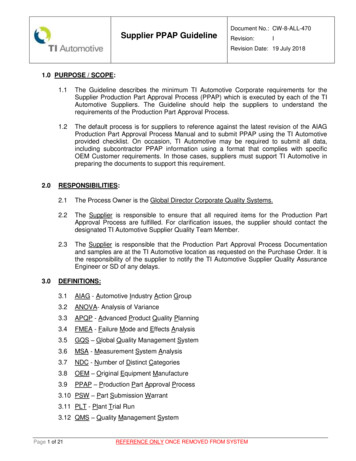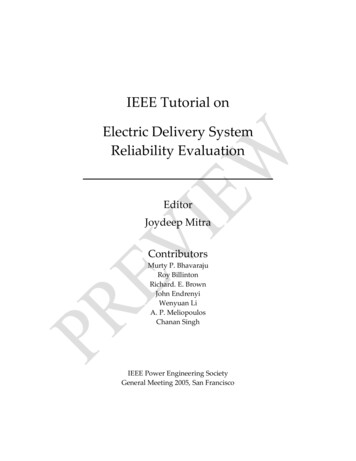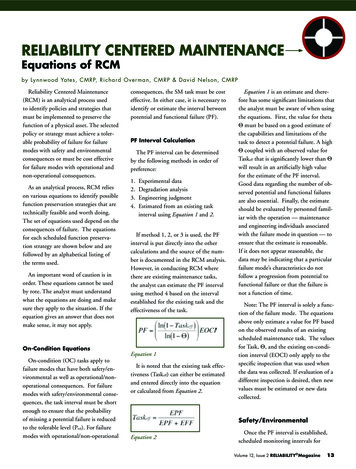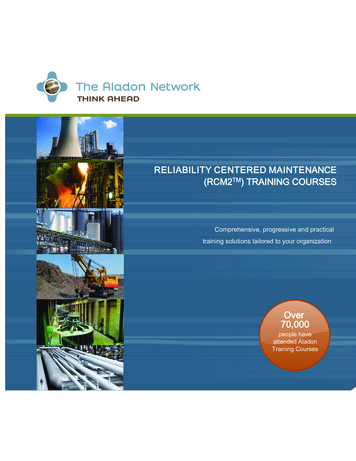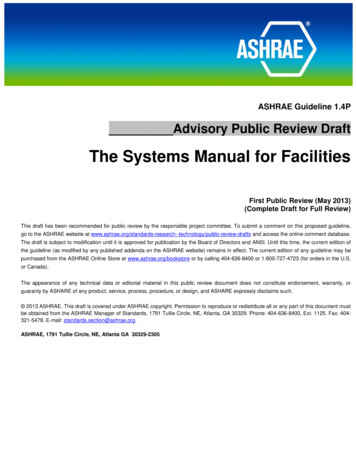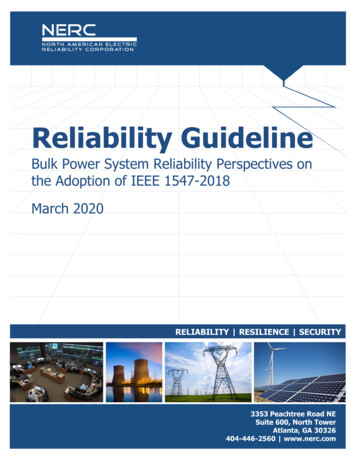
Transcription
Reliability GuidelineBulk Power System Reliability Perspectives onthe Adoption of IEEE 1547-2018March 2020RELIABILITY RESILIENCE SECURITYNERC Report Title Report DateI
Table of ContentsPreface . iiiPreamble . ivExecutive Summary . vIntroduction . viiPotential Impacts of DERs on BPS Reliability. viiBackground of IEEE 1547-2018 . viiiImplementation of IEEE 1547-2018. viiiCoordination between Distribution and Transmission Entities. xiChapter 1: BPS Perspectives on IEEE 1547-2018 Clauses . 1Clause 1.4: General Remarks . 1Clauses 6.4.1 and 6.4.2: Voltage Mandatory Tripping and Ride-Through . 3Clause 6.4.1: Mandatory Voltage Tripping Requirements . 4Clause 6.4.2: Voltage Disturbance Ride-Through Requirements . 5Clauses 6.5.1 and 6.5.2: Frequency Mandatory Tripping and Ride-Through . 7Clause 6.5.1: Mandatory Frequency Tripping Requirements . 7Clause 6.5.2: Frequency Disturbance Ride-Through Requirements . 8Clause 6.4.2.7: Restore Output . 9Clause 6.5.2.7: Frequency-Droop . 10Clause 6.5.2.7.1: Frequency-Droop Capability . 11Clause 6.5.2.7.2: Frequency-Droop Operation . 12Clause 6.5.2.8: Inertial Response . 13Clause 6.5.2.6: Voltage Phase Angle Changes Ride-Through . 13Clause 4.10 and Clause 6.6: Enter Service and Return to Service . 14Clause 8.1: Unintentional Islanding . 15Clause 8.2: Intentional Islanding . 16Clause 10: Interoperability, Information Exchange, and Protocols. 16Appendix A: References . 18Appendix B: Ride-Through Requirements in IEEE 1547-2018. 20Appendix C: Definitions used in IEEE 1547-2018 . 22Contributors . 24NERC Reliability Guideline: Bulk Power System Reliability Perspectives on the Adoption of IEEE 1547-2018 March 2020ii
PrefaceElectricity is a key component of the fabric of modern society and the Electric Reliability Organization (ERO) Enterpriseserves to strengthen that fabric. The vision for the ERO Enterprise, which is comprised of the North American ElectricReliability Corporation (NERC) and the six Regional Entities (REs), is a highly reliable and secure North American bulkpower system (BPS). Our mission is to assure the effective and efficient reduction of risks to the reliability and securityof the grid.Reliability Resilience SecurityBecause nearly 400 million citizens in North America are counting on usThe North American BPS is divided into six RE boundaries as shown in the map and corresponding table below. Themulticolored area denotes overlap as some load-serving entities participate in one Region while associatedTransmission Owners/Operators participate in another.MROMidwest Reliability OrganizationNPCCNortheast Power Coordinating CouncilRFReliabilityFirstSERCSERC Reliability CorporationTexas RETexas Reliability EntityWECCWestern Electricity Coordinating CouncilNERC Reliability Guideline: Bulk Power System Reliability Perspectives on the Adoption of IEEE 1547-2018 March 2020iii
PreambleIt is in the public interest for NERC to develop guidelines that are useful for maintaining or enhancing the reliabilityof the Bulk Electric System (BES). The NERC technical committees (the Operating Committee (OC), the PlanningCommittee, and the Critical Infrastructure Protection Committee (CIPC)) are authorized1 by the NERC Board ofTrustees (Board) to develop reliability (OC and Planning Committee) and security guidelines (CIPC) per their charters.These guidelines establish a voluntary code of practice on a particular topic for consideration and use by BES users,owners, and operators. These guidelines are coordinated by the technical committees and include the collectiveexperience, expertise, and judgment of the industry. The objective of this reliability guideline is to distribute keypractices and information on specific issues critical to maintaining the highest levels of BES reliability. Reliabilityguidelines are not to be used to provide binding norms or create parameters by which compliance to standards ismonitored or enforced. While the incorporation of guideline practices is strictly voluntary, reviewing, revising, ordeveloping a program using these practices is highly encouraged to promote and achieve the highest levels ofreliability for the BES.NERC, as the Federal Energy Regulatory Commission (FERC) certified ERO,2 is responsible for the reliability of the BESand has a suite of tools to fulfill this responsibility, including (but not limited to) lessons learned, reliability and securityguidelines, assessments and reports, the Event Analysis Program, the Compliance Monitoring and EnforcementProgram, and mandatory standards. Each entity—as registered in the NERC compliance registry—is responsible andaccountable for maintaining reliability and compliance with the mandatory standards to maintain the reliability oftheir portions of the BES. Entities should review this guideline in detail in conjunction with the periodic review of theirinternal processes and procedures and make any needed changes to their procedures based on their system design,configuration, and business er%202013.pdf2 .pdfNERC Reliability Guideline: Bulk Power System Reliability Perspectives on the Adoption of IEEE 1547-2018 March 2020iv
Executive SummaryNERC has focused on ensuring the reliable operation of the BPS under increasing penetrations of BPS-connectedinverter-based resources as well as distributed energy resources (DERs).3 The NERC Integrating Variable GenerationTask Force (IVGTF)4 also stated that large amounts of DERs5 connected to the grid could have significant effects onthe reliability of the BPS. Of main concern was the lack of disturbance ride-through capability.6 The NERC DistributedEnergy Resources Task Force (DERTF) report7 further characterized the impacts that DERs may have on BPS reliability.Recent BPS disturbances have illustrated the need for fault ride-through capability,8 particularly the need for voltagephase angle jump ride-through and rate-of-change-of-frequency ride-through capability.9 Lastly, the NERC LoadModeling Task Force (LMTF) developed a modeling framework and recommended adopting practices for studyingthe aggregate impacts that DERs may have on the BPS. The NERC System Planning Impacts of Distributed EnergyResources Working Group (SPIDERWG) is further analyzing these impacts and developing recommended practicesand industry guidance.IEEE Standard 1547-2018 Standard for Interconnection and Interoperability of Distributed Energy Resources withAssociated Electric Power Systems Interfaces (referred to herein as “IEEE 1547-2018”) was published in April 2018and significantly enhanced the performance and functional capability of DERs connecting specifically to primary andsecondary distribution systems. IEEE 1547-2018 is intended to apply only to DERs connected to the distributionsystem and is generally not suited for other interconnection levels (i.e., resources connecting to the subtransmissionor transmission systems). These new capabilities align with the BPS reliability needs and present opportunities formaintaining or improving BPS reliability with increasing penetration of DERs. The IEEE P1547.1 working group expectsequipment certified to this new standard to become available in the 2021 time frame. This reliability guidelinediscusses the adoption of IEEE 1547-2018 and considerations that should be made during its adoption that reflectBPS reliability perspectives.The timely adoption and implementation of IEEE 1547-2018 for DERs connected to the distribution system acrossNorth America is strongly encouraged. The specifications for DERs in IEEE 1547-2018 include performance capabilitycategories and allowable ranges of functional settings that provide flexibility to align with specific system needs.However, these flexibilities require coordination between distribution and transmission entities for effectiveadoption. The adoption of IEEE 1547-2018 requires the authority governing interconnection requirements (AGIR)10and various stakeholders to get involved at a deeper technical level than in the past.11 Due to the required amountof coordination in IEEE 1547-2018, it is expected that AGIRs may need around two years to develop an effectiveimplementation plan for the standard. Further, DERs compliant with IEEE 1547-2018 are expected to become readilyavailable in 2021, a key incentive for AGIRs to begin the coordination activities for adoption and implementation ofthe standard.3NERC Summary of Activities: BPS-Connected Inverter-Based Resources and Distributed Energy Resources (September ry of Activities BPS-Connected IBR and DER.pdf.4 NERC IVGTF, “Summary and Recommendations of 12 Tasks,” June %20Summary%20and%20Recommendation%20Report Final.pdf5 Refer to the definition of DER provided in IEEE 1547-2018. Also refer to the NERC DERTF definition of a DER that is defined as “any resourceon the distribution system that produces electricity and is not otherwise included in the formal NERC definition of the BES.” Note, however,that generating resources connected to the sub-transmission system should generally be classified as BPS-connected and not as a DER. Thisapplies in this paper.6 This entails voltage ride-through (VRT) and frequency ride-through (FRT) capability.7 skfrcDL/Distributed Energy Resources Report.pdf8 turbances-Report.aspx9 em-operator-s-technical-report10 Per IEEE 1547-2018, the AGIR may be a regulatory agency, public utility commission, municipality, cooperative board of directors, etc.11 IEEE 1547-2003 contained a set of “one-size-fits-all” requirements that did not allow for flexibility of DER settings nor required muchcoordination between transmission and distribution system entities: .NERC Reliability Guideline: Bulk Power System Reliability Perspectives on the Adoption of IEEE 1547-2018 March 2020v
Executive SummaryThis reliability guideline provides high-level guidance12 and BPS reliability perspectives that should be consideredduring the adoption and implementation of IEEE 1547-2018. Specifically, this guideline focuses on issues that pertainto DERs that have been identified by NERC SPIDERWG as potentially having an impact on the BPS. The guidanceprovided herein is intended to support state regulators’ adoption and implementation of IEEE 1547-2018 asregulators are the entity most likely to fill the role of the AGIR in many cases.13 The materials presented will also likelyaid AGIRs in coordinating with Distribution Providers (DPs), Balancing Authorities (BAs), Reliability Coordinators (RCs),and other entities navigating adoption of IEEE 1547-2018 and its requirements. Each of the capability requirementsand functional settings require coordination with the RC for their area.14 This reliability guideline will address keyclauses in IEEE 1547-2018 in detail to ensure that BPS reliability perspectives and recommended considerations aremade clear. These include, but are not limited, the following: voltage and frequency mandatory trip settings, ridethrough capability, DER enter service and return to service operation, DER controls configuration, and interoperabilityand local DER communication interface considerations.12Readers are encouraged to become familiar with IEEE 1547-2018, which goes beyond BPS-related issues. Be aware that IEEE 1547 is subjectto change. For example, since IEEE 1547-2018 was approved, the IEEE Standards Association has issued an errata for IEEE 1547-2018 in June2018 and has also approved a Project Authorization Request in September 2019 for an amendment to the standard.13 The term “authority governing interconnection requirements” is introduced in IEEE 1547-2018 and in most cases is likely the state regulatoryutility commission.14 IEEE 1547-2018 specifies the term “regional reliability coordinator” as the functional entity that maintains the real-time operating reliabilityof the BPS within an RC area. This is synonymous with the term RC as defined in the NERC Functional Model. Refer to the NERC website for amap of RC footprints: Coordinators.aspx.NERC Reliability Guideline: Bulk Power System Reliability Perspectives on the Adoption of IEEE 1547-2018 March 2020vi
IntroductionThis guideline provides BPS perspectives that should be considered during the adoption and implementation of IEEE1547-2018.15 It does not cover every specific clause of IEEE 1547-2018; however, it addresses general benefits of thestandard and specific clauses related to BPS reliability. This guideline is not intended to suffice as engagement orcoordination among RCs and other stakeholders nor intended to address regionally-specific consideration; rather, itis intended to serve as a useful reference in these coordination activities. Note that the use of terminology generallymirrors the definitions of IEEE 1547-2018; refer to Appendix C for definitions of terms used.Potential Impacts of DERs on BPS ReliabilityAt low penetration levels, DERs may not pose a significant risk to BPS reliability. However, as the penetrationcontinues to increase across many parts of North America, the aggregate effects of DERs present both challenges andopportunities for planning, design, and operation of the BPS. NERC has been analyzing the impacts that DERs canhave on the BPS, including key findings and recommendations from the NERC IVGTF report16 and the NERC DERTFreport.17 These efforts and the ongoing work by the NERC SPIDERWG are focusing on the aggregate impact that DERscan have on BPS reliable operation. Of particular focus are the following areas: The impacts that DERs have by offsetting gross load, resulting in the displacement of BPS generation whichare providing various essential reliability services (ERSs) The impacts that DERs have on balancing generation and demand, and ensuring that BAs are carrying asufficient amount of resources to meet ramping requirements The ability of the BPS to have adequate levels of voltage regulation and reactive power support withincreasing penetration of DERs The impacts that legacy DER ride-through and trip settings may have on BPS performance following largedisturbances The ability to model and forecast DERs for the purposes of planning and operations studies The ability to ensure BPS reliability with increasing amounts of generation that are not currently observable18or dispatchableThe aggregate effect of many DERs distributed across the interconnected BPS is already having an impact on BPSplanning and operations. For example, the California Energy Commission Integrated Energy Policy Report forecastsapproximately 6,845 MW of DERs within the California Independent System Operator footprint.19 In response to theirconcerns about DERs, the California Public Utility Commission adopted CA rule 21,20 which identified andimplemented many of the functional capabilities that are now included in IEEE 1547-2018 and mandated that all solarPV DERs installed (starting September 9, 2017) use “smart inverters” to provide grid support and help address theissues described above. Thousands of MWs of DERs have been installed in California since that time with smartinverter functionality mandated by CA Rule 21. However, much of the installed equipment (i.e., legacy andard/1547-2018.html.NERC IVGTF, Integration of Variable Generation Task Force Report: Summary and Recommendations of 12 Tasks, June %20Summary%20and%20Recommendation%20Report Final.pdf17 NERC DERTF, Distributed Energy Resources: Connection Modeling and Reliability Considerations, February rvcstskfrcDL/Distributed Energy Resources Report.pdf18 The inability for BPS grid planners and operators to understand the DER location, equipment standardization, on-line performance andbehavior to grid events may pose significant challenges in both planning and operational time horizons and will increase in severity as thepenetration of DERs continues to increase.19 https://ww2.energy.ca.gov/2019 energypolicy/20 https://www.cpuc.ca.gov/Rule21/16NERC Reliability Guideline: Bulk Power System Reliability Perspectives on the Adoption of IEEE 1547-2018 March 2020vii
Introductionthat could trip rather than ride through disturbances (those that predate the update to CA Rule 21) will likely remainfor decades.Background of IEEE 1547-2018IEEE 1547-2018 is a newly published IEEE standard that specifies minimum technical interconnection andinteroperability requirements for DERs connected to the distribution system.21 Changes in the -2018 version of thestandard address issues in the original -2003 version that required updating due to technology developments andrecent learnings.22 At a high level, the new standard introduces the following key elements: Expanding the scope of the prior IEEE 1547 standard by considering BPS issues, such as ride-throughrequirements, as well as distribution system issues23 Extending requirements from the interconnection system and the individual DER unit to the whole DERfacility (i.e., DER system) (For example, DER auxiliary equipment will now be capable of withstanding specifiedvoltage and frequency disturbances.) Expanding the applicability beyond individual equipment such that it can be used for plant-level verification Specifying capabilities and functions necessary in a local DER communication interface (e.g. interoperabilityconsiderations) in addition to the electrical performance of the DER at its connection point24 Enabling DERs to have the capability of providing autonomous response to voltage and frequency changes tosupport the grid, including voltage regulation and frequency-droop responseOther new requirements include prioritization of DER functions, measurement accuracy requirements, and powerquality requirements. The Interstate Renewable Energy Council (IREC) published a review of changes in the -2018version for state regulators25 and the National Rural Electric Cooperative Association (NRECA) published a guide forcooperative utility engineers.26 The Electric Power Research Institute (EPRI) reviewed experience with the standard’simplementation to date27 and has published materials related to BPS issues as well.28Implementation of IEEE 1547-2018IEEE 1547-2018 is intended to apply only to DERs connected to the distribution system and is generally not suited forother interconnection levels (i.e., resources connecting to the subtransmission or transmission systems).29 BPSconnected inverter-based resources should follow the recommendations set forth by NERC,30 are required to 21/standards/1547rev/.23 For example, lack of ride-through capability can have a negative impact on BPS reliability. This was observed in the Palmdale Roost andAngeles Forest disturbances in North America and in the August 2019 disturbance that occurred in the United al-report.24 Once communications networks are deployed, utilities or aggregators can communicate with this interface to monitor, control, and exchangeinformation with DERs.25 ard-1547-2018-for-distributedenergy-resources/.26 rch-2019.pdf.27 2019.03-F2 TemplateIntegratedGrid.pdf.28 /000000003002014547/.29 The NERC Inverter-Based Resource Performance Task Force (IRPTF) identified misapplication of IEEE 1547 for BPS-connected inverterbased resources due to its linkage with UL 1741 Standard: https://www.nerc.com/comm/PC Reliability Guidelines DL/InverterBased Resource Performance Guideline.pdf.30https://www.nerc.com/comm/PC Reliability Guidelines DL/Inverter-Based Resource Performance Guideline.pdf22NERC Reliability Guideline: Bulk Power System Reliability Perspectives on the Adoption of IEEE 1547-2018 March 2020viii
Introductionlocal utility interconnection requirements,31 and are expected to be required to meet the future requirements beingdeveloped by IEEE P2800 (which is the transmission counterpart to IEEE 1547).32 IEEE 1547-2018 is technology-neutraland was vetted by a large group of industry stakeholders that range from DER manufacturers to distribution andtransmission utilities. The goal of IEEE 1547-2018 implementation is to harmonize technical interconnectionperformance capability requirements and functional specifications for the growing installations of DERs.33Development of IEEE 1547-2018 considered different regional- and utility-specific situations as well as the currentand anticipated future capabilities of the technology to safely and reliably interconnect DERs to the grid.Entities will need to ensure that updates to interconnection requirements and the implementation of IEEE 1547-2018align with the rollout of equipment compliant with the standard.34Authority Governing Interconnection RequirementsIEEE standards are voluntary in nature, so state regulators, local distribution utilities, or other applicable governingbodies throughout North America must adopt them. The FERC Small Generator Interconnection Procedures andEnergy Policy Act of 2005 reference IEEE 1547 and any updates to the standard, so DERs whose interconnections aresubject to FERC jurisdiction are likely subject to the requirements of IEEE 1547-2018. Similarly, AGIRs should ensureappropriate adoption and implementation of IEEE 1547-2018 in interconnection requirements for all other DERs notsubject to FERC jurisdiction. In many cases, interconnection requirements for DERs may need to be modified toaccommodate the new standard.In February 2020, the National Association of Regulatory Utility Commissioners (NARUC) approved a resolution thatrecommended state utility commissions adopt and implement IEEE 1547-2018.35 The resolution grants flexibility forstate commissions, recognizing the unique procedures, priorities, and needs for each state while also consideringbest practices identified by technical experts. The resolution also recognizes IEEE 1547-2018 for convening astakeholder process, utilizing existing research and experience to make evidence-based decisions, and aligning theimplementation of the standard with the availability of certified equipment.IEEE 1547-2018 includes performance categories and functional settings that allow significant flexibility; however,selecting the appropriate settings requires stakeholder involvement. The standard introduces the concept of theAGIR, which is defined in IEEE 1547-2018 as follows:36“Authority Governing Interconnection Requirements (AGIR): A cognizant and responsible entity thatdefines, codifies, communicates, administers, and enforces the policies and procedures for allowing electricalinterconnection of DER to the area Electric Power System (EPS). This may be a regulatory agency, public utilitycommission, municipality, cooperative board of directors, etc. The degree of AGIR involvement will vary inscope of application and level of enforcement across jurisdictional boundaries. This authority may bedelegated by the cognizant and responsible entity to the Area EPS operator or bulk power systemoperator.”37As stated, an AGIR can be a state regulator or a municipal or cooperative governing board. DPs should be aware thata high degree of technical involvement is necessary for successfully implementing IEEE 1547-2018. Additionally,31https://www.nerc.com/comm/PC Reliability Guidelines DL/Reliability Guideline IBR Interconnection Requirements t/2800.html.33 Including distributed generation and energy storage systems.34 7rev/35 -8B6C4DE0F7C736 2018.html.37 IEEE 1547-2018 also states: “NOTE—Decisions made by an authority governing interconnection requirements should consider variousstakeholder interests, including but not limited to Load Customers, Area EPS operators, DER operators, and bulk power system operator.”32NERC Reliability Guideline: Bulk Power System Reliability Perspectives on the Adoption of IEEE 1547-2018 March 2020ix
Introductioncoordination across many stakeholders is also necessary. RCs, Planning Coordinators (PCs), Transmission Planners(TPs), Transmission Owners (TOs), Transmission Operators (TOPs), BAs, state regulatory agencies, manufacturers, anddevelopers will likely all have a stake in how IEEE 1547-2018 is implemented for each local jurisdiction. Collaborationat the state-level and regional-level are encouraged to engage all necessary stakeholders. The goal is that involvementfrom all interested stakeholders will lead the state regulatory entities and DPs to successful selection of appropriatesettings within IEEE 1547-2018 and appropriate enforcement of the standard across all DERs connecting to their grid.It is expected that the collaboration process of reaching consensus between all interested parties regarding assigningvoltage and frequency ride-through performance categories and determining regional voltage and frequency trip38setting (thresholds and clearing times) could take around two years. Utilizing DER communication and interoperabilitycapabilities will also requ
adoption. The adoption of IEEE 1547-2018 requires the authority governing interconnection requirements (AGIR)10 and various stakeholders to get involved at a deeper technical level than in the past.11 Due to the required amount of coordination in IEEE 1547-2018, it is expected tha


